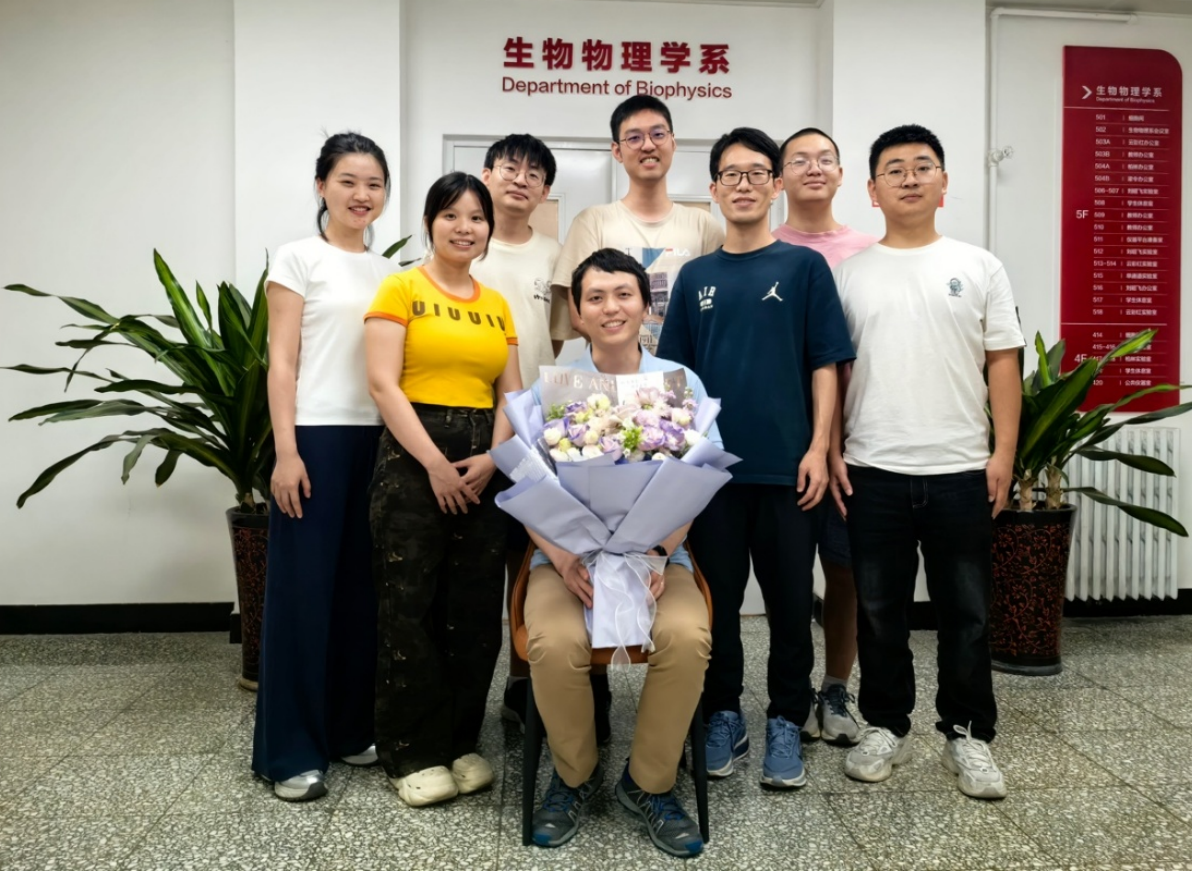Department of Biophysics
Ling Liang

Ling Liang, Principal Investigator, Assistant Professor
Contact Information
Email: liangling@bjmu.edu.cn
Personal Profile
I earned a Ph.D. in Pathology from Peking University in 2016. My research focuses on elucidating the molecular mechanisms of important protein complexes, particularly the machinery of protein degradation, nutrient sensing and transport, and their roles in tumorigenesis, cancer progression and therapy. I have served as Principal Investigator for projects supported by the National Natural Science Foundation of China (NSFC), including the Young Scientists Fund and the General Program. Over the past five years, I have (co-)authored multiple SCI-indexed papers as first or corresponding author in leading international journals, including Nature Communications (2020, 2024, 2025a, 2025b), Developmental Cell (2021), EMBO Journal (2024), and Chemical Engineering Journal (2024a, 2024b). I currently serve as a Young Committee Member of the Cryo-Electron Microscopy Branch of the Biophysical Society of China, and as a member of the Youth Working Group under the Systems Biomedicine Committee of the Chinese Association of Pathophysiology. I have applied for three patents for invention, one of which has been granted.
Research
Our research integrates cryo-electron microscopy (cryo-EM), X-ray crystallography, biochemistry, molecular dynamics simulations, and other experimental and computational approaches to systematically investigate the regulation of disease-related proteins and the assembly mechanisms of macromolecular complexes. We further employ artificial intelligence (AI)-driven protein design to advance the development of novel targeted therapeutic strategies for cancers and other diseases.
(1) The regulatory mechanism of the mTORC1 signaling pathway, providing a novel structural basis and targeted intervention strategies for the treatment of metabolic diseases and cancer;
(2) The dynamic assembly mechanism of key DNA damage repair complexes, offering new theoretical foundations for targeted cancer therapy;
(3) E3 ubiquitin ligases and the proteasome, proposing new avenues for the development of targeted protein degradation drugs.
Brief Research
Structural biology and AI-driven mechanism investigation and precision intervention for diseases
Education and Work Experience
2008.09–2013.07 Peking University, Bachelor of Medicine (8-year program) in Basic Medicine
2013.09–2016.07 Peking University, Doctor of Medicine in Pathology
2016.08–2021.07 Peking University, Department of Biochemistry and Biophysics, Lecturer
2021.08–present Peking University, Department of Biophysics, Assistant Professor
Teaching Courses
Undergraduate: “Frontiers in Technology for Medicine: Biomolecular Condensates”, “Technology in Medicine III (Part 2)”, “PBL”, “Biochemical Experiments”, “Innovative Integrated Experiments”.
Graduate: “Medical Biophysics: Membranes and Biomacromolecules”, “Research Techniques in Structural Biology”, “Techniques for Studying Biomacromolecular Interactions”, Electron Microscopy Methods in Biomedicine.
Group Members
Ph.D. Candidates: Chuanda Zhu, Ao Yang, Shang Yu, Lu Qin, Haoyu Wang, Jiye Zheng, Shuxin Ji.

Publications (#Co-first author,*Co-corresponding author)
(1) Shang Yu#, Jin-hui Ding#, Jia-le Wang#, Weize Wang, Peng Zuo, Ao Yang, Zonglin Dai, Yuxin Yin, Jin-peng Sun* and Ling Liang*, Structural insights into cholesterol sensing by the LYCHOS-mTORC1 pathway, Nature Communications , 2025, 16:6792.
(2) Peng Zuo, Weize Wang, Zonglin Dai, Jiye Zheng, Shang Yu, Guangxi Wang, Yue Yin, Ling Liang*, Yuxin Yin*, Synergistic activation of the human phosphate exporter XPR1 by KIDINS220 and inositol pyrophosphate, Nature Communications , 2025, 16:2879.
(3) Weize Wang#, Ling Liang#*, Zonglin Dai#, Peng Zuo, Shang Yu, Yishuo Lu, Dian Ding, Hongyi Chen, Hui Shan, Yan Jin, Youdong Mao, Yuxin Yin*, A conserved N-terminal motif of CUL3 contributes to assembly and E3 ligase activity of CRL3KLHL22, Nature Communications , 2024, 15: 3789
(4) Ling Liang#*, Jiawen Feng#, Peng Zuo, Juan Yang, Yishuo Lu, Yuxin Yin*, Molecular basis for assembly of the shieldin complex and its implications for NHEJ, Nature Communications , 2020, 11: 1972
(5) Yuan Wang#, Chunlei Zhang#, Wenzhong Yang, ShiPeng Shao, Xinmin Xu, Yujie Sun, Pilong Li, Ling Liang*, Congying Wu*, LIMD1 phase separation contributes to cellular mechanics and durotaxis by regulating focal adhesion dynamics in response to force, Developmental Cell , 2021, 56(9): 1-13
(6) Zonglin Dai#, Ling Liang#, Weize Wang#, Peng Zuo, Shang Yu, Yaqi Liu, Xuyang Zhao, Yishuo Lu, Yan Jin, Fangting Zhang, Dian Ding, Weiwei Deng, Yuxin Yin, Structural insights into the ubiquitylation strategy of the oligomeric CRL2FEM1B E3 ubiquitin ligase, EMBO Journal , 2024, 43(6): 1089-1109
(7) Chuanda Zhu, ZongLin Dai, Lu Qin, Jing Wang, Ling Liang*. Efficient cytosolic delivery of proteins enabled by modular fusion protein. Chemical Engineering Journal , 2024; 497(1):154619
(8) Chuanda Zhu#; Xi Chen#; Jingjing Gong; Jiao Liu; Lidong Gong; Zeliang Yang; Zhenyu Zhu; Qiang Zhang; Tiancheng Li*; Ling Liang*; Zhiqiang Lin*; An elastase nanocomplex with metal cofactors for enhancement of target protein cleavage activity and synergistic antitumor effect, Chemical Engineering Journal , 2024, 485: 149902
(9) Chang Song#, Ling Liang#, Yan Jin, Yunqiao Li, Yang Liu, Limei Guo, Congying Wu, Cai-Hong Yun*, Yuxin Yin*, RCC2 is a novel p53 target in suppressing metastasis, Oncogene , 2018, 37(1): 8~17
(10) Ling Liang#, Yuhua Li#, Xing Tian, Juntuo Zhou*, Lijun Zhong*, Comprehensive lipidomic, metabolomic and proteomic profiling reveals the role of immune system in vitiligo, Clinical and Experimental Dermatology , 2019, 44(7): e216-e223
(11) Ling Liang, Xiao-E Yan, Yuxin Yin*, Cai-Hong Yun*, Structural and biochemical studies of the PDGFRA kinase domain, Biochem. Biophys. Res. Commun. , 2016, 477(4): 667~672
(12) Xiao-E Yan#, Pelin. Ayaz#, Su-Jie Zhu#, Peng Zhao#, Ling Liang, Casey H. Zhang, Ya-Chuang Wu, Je-Luen Li, Hwan Geun Choi, Xin. Huang, Yibing Shan*, David E. Shaw*, Cai-Hong Yun*, Structural basis of AZD9291 selectivity for EGFR T790M, Journal of Medicinal Chemistry , 2020, 63(15): 8502-8511

